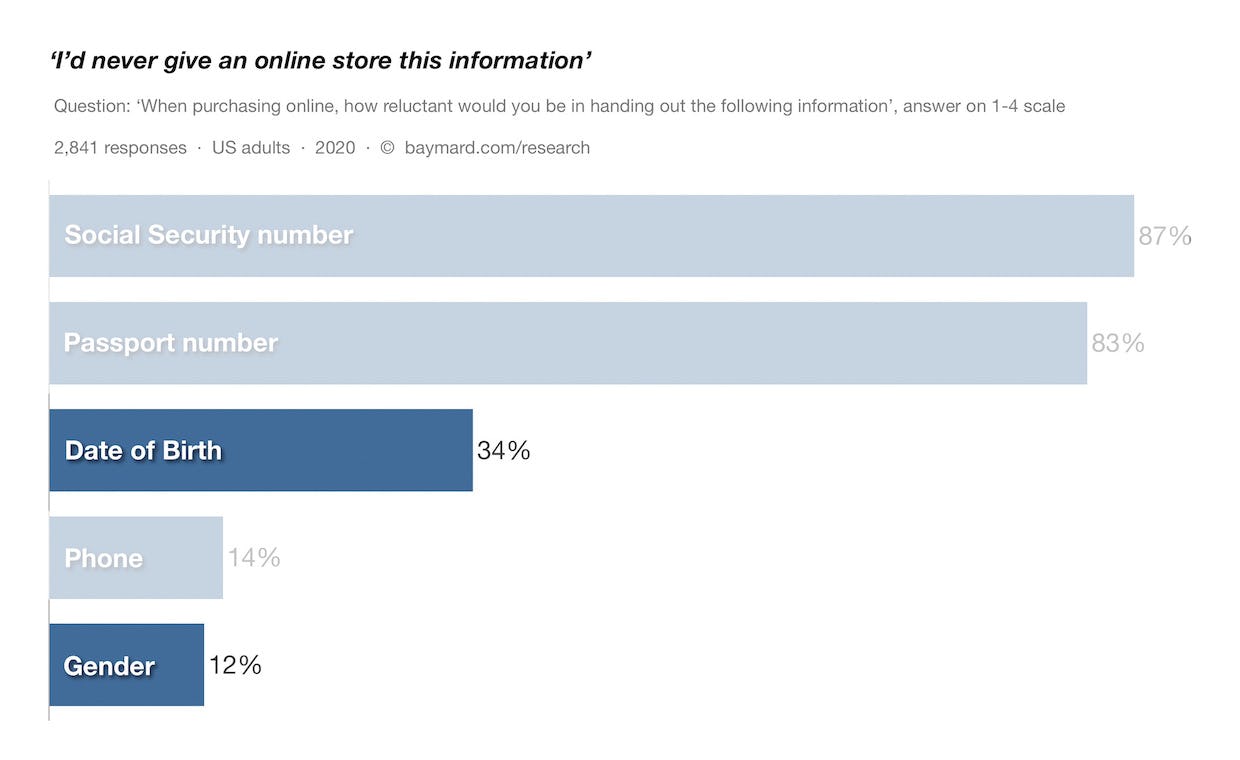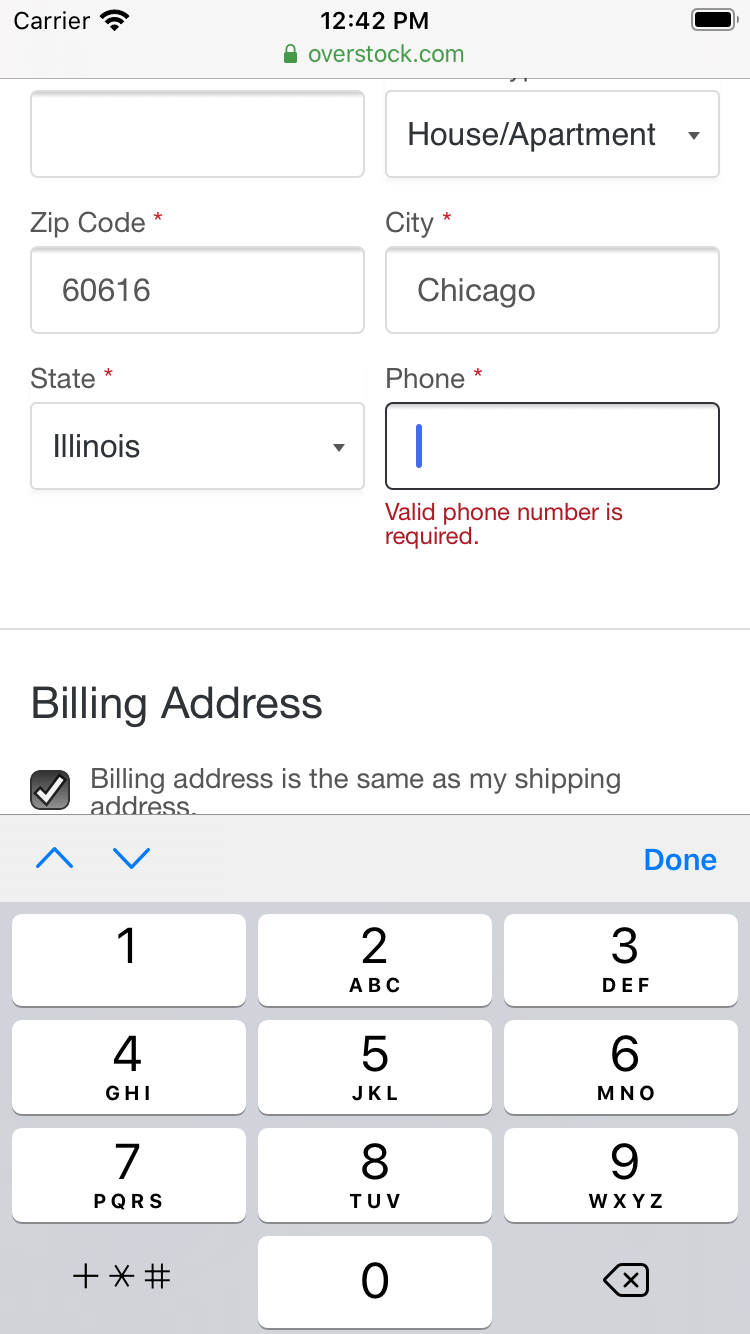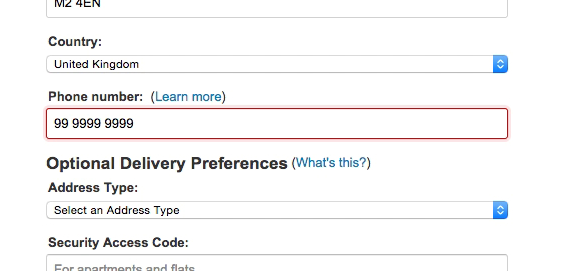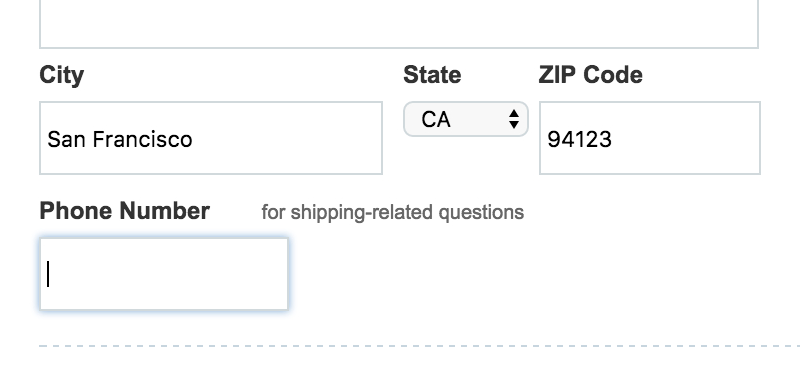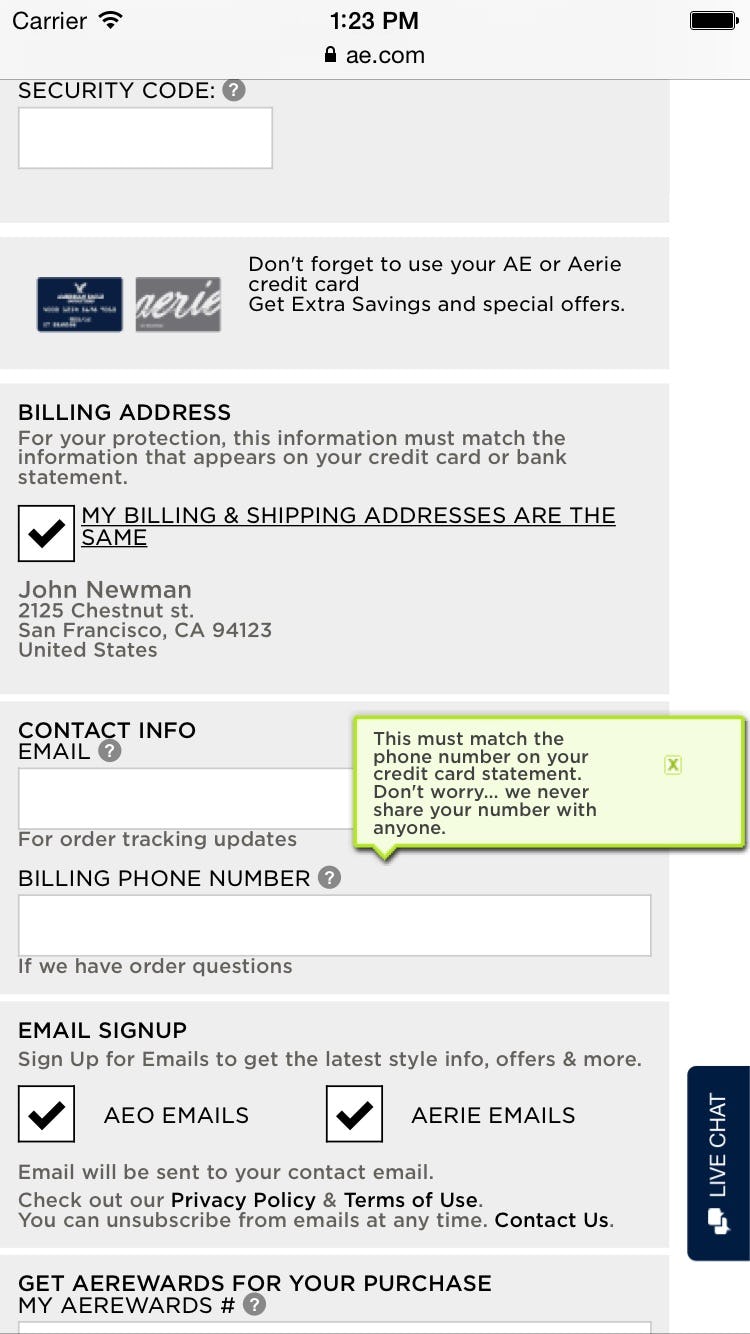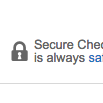Video Summary
Users continue to be concerned about the security and confidentiality of their personal information on the web. This can range from serious concerns over identity theft to more mundane concerns, such as an aversion to receiving marketing phone calls — making users reluctant to hand out personal information.
In particular, our benchmarking reveals that the “Phone Number” field is required during the checkout flow on 97% of the 60 largest e-commerce sites — but 58% of sites don’t provide an explanation for why it’s needed.
During Baymard’s large-scale usability testing, required but unexplained phone fields were observed to be a direct cause of abandonments for the subgroup of users who are suspicious of a site’s motives.
Furthermore, a few other sites also ask users for other personal information during checkout, such as date of birth and gender. Our testing also verifies that this is considered highly personal information for some users, who similarly will refuse to give out this information to complete the checkout.
In this article, we’ll discuss the test findings from our Baymard Premium UX research database, related to required “Phone Number” fields. In particular, we’ll discuss:
- Quantitative results that indicate users are highly reluctant to provide phone numbers without an explanation
- Qualitative usability test results that support these findings
- How providing an explanation for why the phone number is needed can mitigate the issue
Phone Number Field Insights: Quantitative Results on Phone Numbers and Privacy
Baymard’s quantitative study of over 2,800 online shoppers reveals that 14% of respondents indicated they won’t provide their phone number to complete a checkout.
Yet “Phone Number” is required to complete the checkout at almost all e-commerce sites — making this one field a potential sole cause of abandonment.
Many sites likely don’t think of a user’s phone number as highly sensitive information that users would be reluctant to provide. After all, for many sites the phone number is required for legitimate reasons — for example, many shipping couriers require it in order to process the package, or the site may use it if there are problems with the order or simply to provide text updates on the order status.
Yet this is clearly not the case for 14% of respondents in our quantitative study, for whom being required to provide this information is a “deal breaker”.
Additionally, date of birth and gender — which are required on only 5% of sites — would also lead to many users abandoning the checkout (34% for date of birth and 12% for gender).
Thus, while users are far less likely to encounter required “Date of Birth” and “Gender” fields during checkout, more than twice as many users would be likely to abandon if they’re asked for their date of birth, and roughly as many would be likely to abandon if they’re asked for their gender, compared to the “Phone Number” field.
To further investigate the phone number and privacy issue, we’ve conducted large-scale usability testing to determine how users respond to required phone numbers when faced with the field during an actual checkout flow. The results largely support our findings from the quantitative testing.
Qualitative Results on Phone Numbers and Privacy
Consistently during all our checkout usability studies a large proportion of users voiced strong privacy concerns when required to hand out their phone number.
- “Look. Why do they need my phone number? What do they need that for? They don’t need it!”
- “Well I don’t really understand what they need the phone number for? Usually it’s enough that my address is there. You see, all communication goes by email. I’ve never tried being called by any website, and usually they are pretty hard to get ahold of themselves if you need customer service. So I think it’s weird.”
- “Normally I wouldn’t fill in something like ‘phone number’ on a site like this [Amazon]. I simply can’t see what they need that for.”
- “They want a phone number. Um, well, it’s an address, one shouldn’t think that they need to call him, so I don’t know why it’s a requirement [the user is buying an item as a gift]. I’d type my own number here. When it’s a gift I’d prefer that ASOS calls me instead of him.”
- “That’s annoying. They want too much information….They can do without my phone number. Afterwards somebody from India is trying to call me and cheat me. Both me and my husband received calls [from] guys with a very heavy accent trying to speak English telling me ‘go to your computer it has a virus, just click this’. It’s from those sites they get them somehow.”
- “I’m looking at how I can proceed as fast as possible. They’ve been so nice to write ‘optional’ out there. But then I find that this one isn’t optional [phone number]. That’s super annoying. I don’t want to. Really. I don’t have any desire to give them my phone number. [Slams the keyboard.] Basically I want to type as little as possible. And then I don’t want to be called with any offers, that’s intrusive. It’s a unique ID, so it’s like registration, I’d prefer to be anonymous. And with a thing like this I don’t think they should have my phone number.”
Clearly, many users have strong feelings regarding providing their phone number. Most users simply don’t intuitively understand why a phone number is necessary, since communication with the e-commerce site is primarily by email, and hence assume the worst — which is that sites want their phone number for marketing or other purposes unrelated to the current order.
During testing we observe that being required to provide a phone number will cause most users to stop and hesitate, but will cause more privacy-concerned users to abandon the site.
“Arhh. Well now they get a phone number. I do this very often. I don’t want to be called by some sales dude. That happens sometimes and…it turns me off completely. They aren’t allowed to do that, I’ve provided my phone number because of the order, then they are not supposed to call me [with a sales call]. But now I’ve learned to type ‘9999’…” This user typed in a fake number when required to provide a phone number by Amazon.
Furthermore, when users feel tricked or forced into something, some will respond with creative ways of getting out of the request.
During testing, several users decided to provide a fake phone number, such as the user above who submitted all 9s, in order to get around the site’s requirement. (Submitting a fake phone number is typically observed for more web-savvy test users.)
If the site had a legitimate reason for requesting the phone number — for example, if a phone number is required for delivery purposes by a courier service — then obviously a fake number is highly problematic.
Even worse is if the phone number is used to validate the credit card data. In this case providing a fake number can lead to almost unresolveable card-validation errors, very likely to cause site abandonments.
Sites should therefore first strongly consider whether a phone number is truly necessary to complete the checkout. If it isn’t, it should be made optional or removed.
Provide Users with a Reason for Why ‘Phone Number’ Is Required
However, for the vast majority of sites the phone number is likely a legitimate requirement needed to fulfill the user’s order.
Yet interestingly, we’ve also consistently observed during testing that sites that require phone numbers, but simply clearly explain why it’s required and what it will be used for, can alleviate the vast majority of users’ privacy concerns.
Simply providing an ultra-short, inline explanation of what the phone number is used for is enough to alleviate the vast majority of privacy concerns. Here, Target explains that the phone number is “for shipping-related questions”.
One well-performing pattern is simply using a short inline explanation in close proximity to the field, such as “Used in case of delivery issues”, “Used for payment validation”, or “For order questions only”, or whatever the information is actually used for. If a longer description is needed, a tooltip can also be used.
3 ways of allaying users’ concerns regarding the “Phone Number” field: a short inline description (first image, at Cabela’s), offering an explanation in a tooltip (second image, at American Eagle), or by making the phone number optional (third image, at Nike).
On mobile, the solutions are the same — removing the “Phone Number” field, making it optional, or letting users know how their phone number will be used. Note however that, on mobile devices, tooltip text in particular tends to present issues for users when proper spacing and hit areas are not implemented correctly, so a short inline description will often be a safe choice implementation wise.
If asking for personal data is a legal requirement, ask only for what the law requires. For example, the brewing company Carlsberg needs to ensure users are over 18, and consequently only asks users for their birth year. This will most likely provoke far-fewer privacy concerns than asking for the full date of birth (and is faster to complete). Users who type a year in which they could be both above and under the required age then get a follow-up field for month, and then one for day, if necessary.
Personal data such as “Date of Birth” and “Gender” are considered to be highly personal by many users; hence, supplying the information should always be optional, or there should be a “de facto optional” option. Here, at Etsy, a “Rather not say” option is provided.
Note that the solutions outlined above for the “Phone Number” field also apply to other fields which users may consider to be asking for sensitive information, such as “Date of Birth” and “Gender”. When the information is truly required from users — for example, when there’s a minimum age to view the site, product, forum, or other account-related feature — consider asking just for their age, not their entire date of birth.
Address Head-On Users’ Concerns Regarding the ‘Phone’ Field
Newegg provides an explanation for why the “Phone Number” field is required, and also provides a link to a more substantial “Privacy Policy”.
The “Phone Number” field is an interesting example of how usability testing can provide a solution to an issue identified during a quantitative study.
Based on the results from our quantitative study, it would seem that requiring users to provide a phone number is simply a bad idea. However, our large-scale usability test sessions proved there’s a simple, low-cost solution that still allows sites to collect this data — offering an explanation for why the phone number is required, to address users’ underlying privacy concerns.
Indeed, several users during testing, facing a required “Phone Number” field, initially responded very negatively and assumed the site was “up to something” (e.g., their number would be used for marketing purposes).
Yet when these same users clicked on a tooltip that described why the phone number was required, it changed their perception of the required field (e.g., “It’s quite good that they want to inform me that the package has now been shipped”).
Yet our benchmark reveals that this easy-to-implement solution is a missed opportunity in e-commerce, as 58% of sites don’t provide an explanation for their required “Phone Number” field during checkout.
This article presents the research findings from just 1 of the 650+ UX guidelines in Baymard – get full access to learn how to create a “State of the Art” ecommerce user experience.



